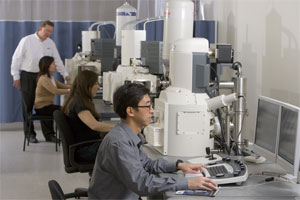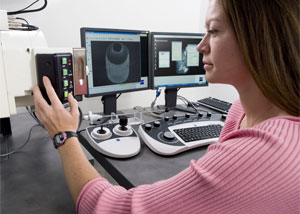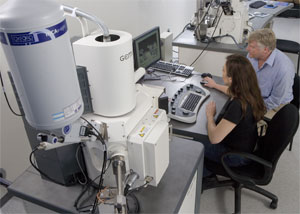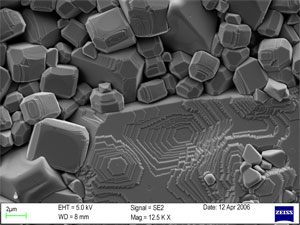Zeiss Center Images the Future in Calit2 Building
By Anna Lynn Spitzer
|
Irvine, Calif., 06.29.06 -- Minuscule is the next big thing.
Nanotechnology – the science of engineering functional systems at the molecular scale – was wishful thinking just 10 years ago. Today, it is poised to make a profound impact on society.
Experts say it will change the face of health care, electronics, packaging, pharmaceuticals, environmental protection, homeland security and much more; in fact, in the near future, nanotechnology is expected to affect 30-plus industries to the tune of more than $61 trillion.
One Millionth of a Millimeter
Nanotechnology is the science of small. A nanometer is one-billionth of a meter, which is equal to one-millionth of a millimeter. How small is that? A human hair is roughly 70,000 nanometers in diameter.
For scientists to build tiny nanosystems, they must be able to slice, dice and examine the minute pieces comprising them. That’s the job of the three new scanning electron microscopes in the Carl Zeiss Center of Excellence, which opened in the Calit2 Building this year.
|
||||
While 70 percent of the lab’s research involves nanotechnology, the Zeiss lab also will be used by biologists, physicists, engineers, geologists, chemists, and even archeologists and anthropologists. Any faculty member on campus – and affiliated researchers – can be trained to use the microscopes.
“It’s truly fostering multidisciplinary research on campus,” says Albert Yee, Calit2 Irvine division director. “There are other electron microscopes on campus, but they can’t do the job as well.”
Advantageous Alliance
The center is a partnership between Calit2@UCI and Carl Zeiss, SMT, a global semiconductor and nanotechnology instrument manufacturer. The strategic alliance is providing a Southern California regional center for nanotechnology and biotechnology research, as well as advanced materials development and innovation.
|
Zeiss supplied the three state-of-the-art electron microscopes, including: the EVO® multi- purpose scanning electron microscope with variable chamber pressure capability; the Ultra 55 CDS ultra-high-resolution field-emission scanning electron microscope; and the 1540 EsB CrossBeam® workstation, a combination of ultra-high resolution field-emission electron beam technology and focused ion beam (FIB) technology. All three instruments, which have a combined value of $2.5 million, are considered leading-edge technology in their respective fields.
Shared Benefit
The equipment will be shared by Calit2’s researchers, its industry partners and Carl Zeiss SMT’s application development team.
The SEM microscopes will be a boon to all three. The high-level microscopy will be particularly useful to Orange County and Los Angeles-based aerospace, biomedical, semiconductor and energy systems industries, which will have the opportunity to use these instruments on a recharge basis. Zeiss will use the lab to demonstrate the instruments’ capabilities and application ranges for its customers. And UCI faculty and students will use it to conduct their research.
According to Peter Clark, president and general manager of Carl Zeiss SMT Inc., Calit2 was a perfect choice for the Center of Excellence . “We wanted an environment that makes a strong and genuine statement of innovation, technology and excellence. Calit2 exactly matches this requirement. It was also clear that UCI has a strong desire to grow and a vision to position itself as one of the leading universities in North America .”
Productive Partnership
Current and potential users are enthused with the technology and its capabilities, says Joe Hovendon, Zeiss district sales manager. He’s brought in aerospace, semiconductor, forensics, materials research and nanotechnology companies for demonstrations, with positive results. “They’re all excited about having the facility here in Southern California , and they’re all looking forward to using it.”
Industry partners will use the equipment as the lab becomes fully staffed. “The biggest hurdle right now is getting everyone here fully trained and qualified to use the microscopes,” says Hovendon. “The demand for this technology is very high.”
Dan Mumm, assistant professor of chemical engineering and materials science, and project scientist John Porter are training student users. At present, 37 UCI students, whose fields range from materials science to chemistry, biology and MEMs, are training on the equipment. Instruction includes a one-hour group orientation and one-on-one training with Mumm or Porter, as well as successful completion of a comprehensive test.
Calit2 is in the final stages of evaluating applicants for a permanent lab manager to oversee training and day-to-day operations. The center will eventually operate 16-24 hours each day.
A Bright Future for Research
The Zeiss Center has the potential to change the Southern California research landscape in important ways. “Southern California is a hotbed of biotech activity,” says Mumm, who was integral in getting the Zeiss partnership established. “In addition to the cluster of small industrial organizations located here, we have a large aerospace and defense industry that continually requires access to high-resolution microscopy. Furthermore, the lab offers easy access, being five minutes from the Orange County airport.”
Zeiss’s president agrees. “Our long-term success will be based on our ability to be present and intimate with the growing nanotechnology communities in the U.S. ,” says Clark . “Southern California is a fast-growing and exciting arena for nanotechnology, thanks especially to its strong local defense companies.”
The microscopy center offers another benefit to UCI and Calit2. As one of only a couple in the country that exists in partnership with an instrument manufacturer, “when Carl Zeiss develops a product innovation, they’ll exchange the existing instruments for those incorporating the latest technologies,” Mumm said. “This partnership will keep us on the forefront of research activity and infrastructure.”
Related Articles
UCI's Carl Zeiss Center of Excellence Celebrates with Open House
Carl Zeiss SMT, Calit2@ UCI Announce Nanotechnology Partnership





